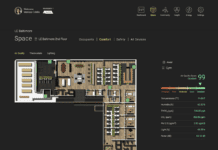By Tyler Haak
The emergence of smart, connected technologies that power the Internet of Things (IoT) has created vast new data sets — and opportunities — for facility managers. However, there is significant work to be done in leveraging this data to better understand how buildings run and maintain healthy and efficient spaces for building occupants.
Despite the continued rise in connected technologies, a recent study commissioned by Schneider Electric found that most facility managers are not maximizing the potential of the internet of things (IoT) through building analytics, with only 32% of respondents stating they currently have analytics solutions in place. On the other hand, more than 90% of respondents thought connecting systems to the internet will ensure smart, productive, profitable operations and allow service providers to deliver better value and maximize energy and sustainability. There is a clear gap between facility managers’ desire to transform their buildings through analytics and taking the steps to develop and execute new IoT strategies.
It’s clear that the IoT provides facility managers with a stronger grasp on how building energy is used and in what ways it can be managed more efficiently. Facility managers can better understand where their time and money are spent, where those valuable resources are wasted, and eliminate that waste in an effective manner. The need for this level of insight has never been greater. According to the U.S. Energy Information Administration, energy use in buildings around the world will increase by 32% by 2040. Most of that usage increase will occur in large, emerging countries where populations continue to shift from rural to urban areas. The Energy Information Administration also predicts that electricity use in buildings will grow 2% annually between 2015 and 2040, as rising standards of living in developing countries increase the demand for appliances, personal equipment and commercial services.
With this increase in energy consumption comes more and more building information that needs to be managed, whether that is the air temperature in a facility, room occupancy, or any number of key data points a building management system (BMS) might monitor in a given week. The IoT enables better information gathering, analysis, and sharing so that facility managers can know exactly what is happening within their facilities, and more quickly diagnose issues and implement solutions that ultimately save energy and valuable resources.
The Role Of Analytics
However, without a way to interpret the raw data figures that are collected by the BMS, the building can be reduced to a black box, leaving facility managers with no understanding of its internal workings. A hyper-connected building has data flowing through it, bringing large amounts of information in to let building managers better direct their building—but without a way to interpret that data, they’re left with a system that is difficult to understand. As a result, it is vital that building analytics lie at the center of any building IoT strategy.
Another factor to consider is information overload. How do facility managers avoid being left with an abundance of disjointed information that is largely unactionable? The best way to do so is to ensure that a building management diagnostic system is in place to make data digestible. This software should be able to run trends analyses, generate reports and let the facility manager organize a schedule to undergo maintenance and diagnose issues. A software analytics platform will allow facility managers to utilize the IoT to view various temperatures, display occupancies and detect faults in a facility’s vital operations throughout the facility, campus or network of buildings.
Facility managers have recognized the utility of IoT and analytics, but they must soon take the next step toward implementation. With a majority of respondents to the aforementioned study predicting that digitization and the IoT will impact their building and maintenance policies within the next year, it will be vital for facility managers to take the steps to retrofit their buildings with the latest building management technologies. These steps include:
- Testing out the use of IoT before implementing it across their entire facility or campus
- Building a solid plan before making any major changes
- Ensuring there is technology integration and interoperability
- Including all key stakeholders in the decision-making process.
When those preparatory steps are taken, a building manager can be confident that they are planning effectively for the future.
 Haak is U. S. northeast business development manager at Schneider Electric, EcoStruxure. He joined Schneider Electric in 2017 to communicate the company’s role in the buildings community. With an educational background in Structural Engineering from Virginia Tech and a Master’s Degree in Energy & Atmosphere Engineering from Stanford, buildings, and in particular how to optimize their energy performance and user experience, have been Haak’s central professional focus during his first decade of work.
Haak is U. S. northeast business development manager at Schneider Electric, EcoStruxure. He joined Schneider Electric in 2017 to communicate the company’s role in the buildings community. With an educational background in Structural Engineering from Virginia Tech and a Master’s Degree in Energy & Atmosphere Engineering from Stanford, buildings, and in particular how to optimize their energy performance and user experience, have been Haak’s central professional focus during his first decade of work.



















![[VIDEO] Collect Asset Data at the Speed of Walking a Building](https://facilityexecutive.com/wp-content/uploads/2024/02/maxresdefault-324x160.jpg)